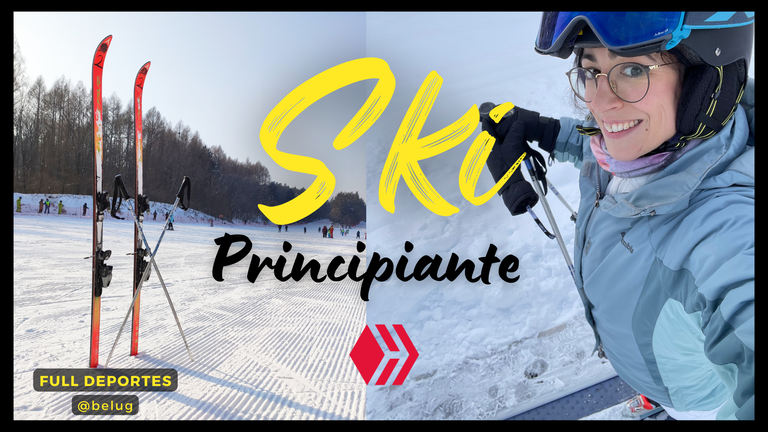
Español
Una nueva experiencia para Full Deportes; Tomé lecciones de ski por primera vez
Amigos de Full Deportes, cómo están? Espero que estén pasando un día maravilloso. Hoy les acerco una experiencia de hace unas semanas atrás, cuando tomé lecciones de ski por primera vez.
Se suponía que debía tomar dos lecciones dos días diferentes, pero al final solo opté por una, ya que el primer día me caí y me dolía la pantorrilla de la pierna derecha.
Podríamos pensar que simplemente era un dolorcillo, pero resulta que estuve con el dolor 10 días, así que fue una buena decisión no hacer la segunda lección.
Les contaré primero el entorno social del ski en mi experiencia en Les Gets, que es algo que hace a los deportes, y luego algunas técnicas que me quedaron grabadas tras aquella clase.
English
A new experience for Full Deportes; I took skiing lessons for the first time
Friends of Full Deportes, how are you? I hope you are having a wonderful day. Today I bring you an experience from a few weeks ago, when I took ski lessons for the first time.
I was supposed to take two lessons on two different days, but in the end I only opted for one, because on the first day I fell and my right calf hurt.
You might think it was just a little pain, but it turned out that I was in pain for 10 days, so it was a good decision not to do the second lesson.
I'll tell you first about the social environment of skiing in my experience in Les Gets, which is something that makes sports, and then some techniques that stuck with me after that lesson.
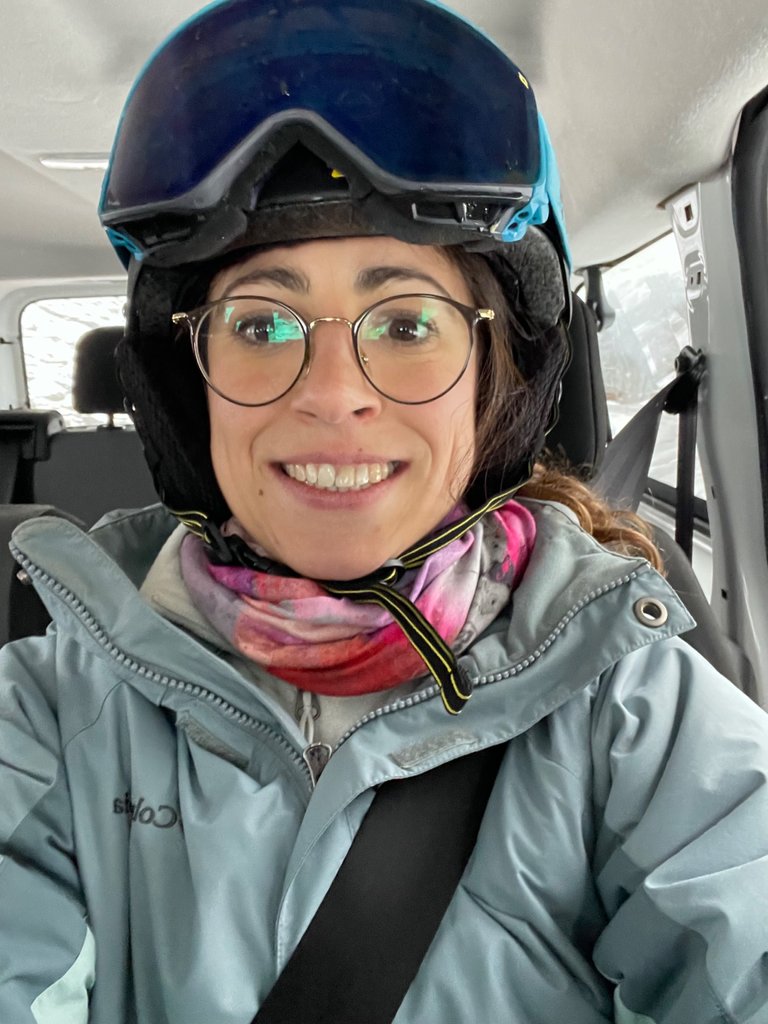
Entorno socioeconómico del ski
Vida social
En lo que es mi grupo de compañeros, se ha generado algo muy particular y es que todos se encuentran para esquiar. Cuando digo todos, me refiero a las 30 personas que conforman el grupo, excepto por mi compañera de cuarto y yo, que justo ninguna de las dos esquía.
Es después del turno de la mañana y antes del turno de la tarde cuando todos se reúnen en las montañas a esquiar y luego se van al apres, que es el bar para después del esquí (sueñen haber varios, pero aquí en Les Gets hay solo uno).
Socio-economic environment of skiing
Social life
In my group of mates, something very particular has been generated and that is that everyone meets to ski. When I say everyone, I mean all 30 people in the group, except for my roommate and I, neither of us skis.
It's after the morning shift and before the afternoon shift that they all meet up on the mountains to ski and then go to the apres, which is the after-ski bar (there may be several, but here in Les Gets there is only one).
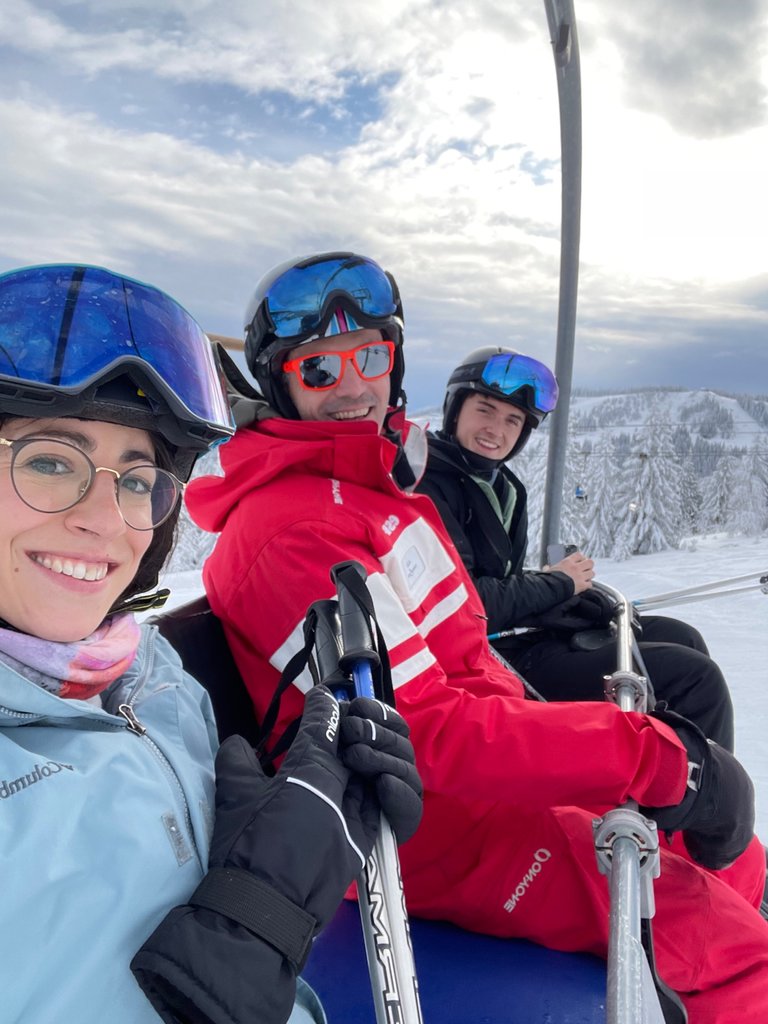
Lesiones
Aunque uno siempre trata de pensar en positivo, al menos yo no he sido capaz de obviar este pequeño detalle. No por querer hacer foco justamente en las posibles lesiones, sino porque estas han ocurrido frente a mí sin siquiera querer informarme al respecto.
Primero se lesionó una de mis compañeras el primer día que esquió, la mandaron a su casa porque se fracturó el tobillo. Luego se lesionaron 3 huéspedes aprendiendo a esquiar. Posteriormente, verán en el video a un chico, Taylor, el estaba aprendiendo conmigo, y ese mismo día después de que me caí, el quiso seguir intentando solo y yo desistí, pues no quería presionarme. Él se lesionó la rodilla aquella tarde, y aunque intentó continuar en el trabajo, tuvo que irse, pues no podía trabajar bien y necesita rehabilitación. Recientemente una compañera que esquía desde los 2 años (tiene 30 años), se lesionó igualmente la rodilla, hace 3 días, y está recuperándose, aunque puede caminar, me asusta el hecho de que sea una persona que tiene muchísima experiencia y se ha lesionado igual.
Por lo tanto mi conclusión es que esquiar es peligroso, y sumado a ello no es algo que me llame demasiado la atención, entonces no encuentro la lógica en arriesgarme por algo que no me incentiva siquiera.
Claro que pienso en que tengo el equipo alquilado por la compañía, los pases de esquí, todo lo que es caro, y no lo estoy aprovechando (demasiado, porque sí que hago mis caminatas). Además me pierdo de compartir con mis compañeros, pero bueno, me quedo con mi Yoga y trekking, jeje.
De todas maneras hay que tener en cuenta que es mucha la gente que esquía, y no todos se lesionan.
Injuries
Although one always tries to think positive, at least I have not been able to overlook this small detail. Not just because I wanted to focus on possible injuries, but because they have happened in front of me without even wanting to inform me about it.
First one of my colleagues was injured on the first day of skiing, she was sent home because she broke her ankle. Then 3 guests were injured learning to ski. Later, you will see in the video a guy, Taylor, he was learning with me, and that same day after I fell, he wanted to keep trying on his own and I gave up because I didn't want to push myself. He injured his knee that afternoon, and although he tried to continue working, he had to leave because he couldn't work well and needs rehabilitation. Recently a colleague of mine, who has been skiing since she was 2 years old (she is 30), also injured her knee 3 days ago, and she is recovering, although she can walk, but I am afraid of the fact that she is a person who has a lot of experience and has been injured in the same way.
So my conclusion is that skiing is dangerous, and added to that it's not something that appeals to me, so I don't see the logic in taking a risk for something that doesn't even encourage me.
Of course I think that I have the equipment rented by the company, the ski passes, everything that is expensive, and I am not taking advantage of it (too much, because I do do my hikes). Besides, I miss out on sharing with my companions, but well, I'll keep my Yoga and trekking, hehe.
Anyway, you have to take into account that there are a lot of people who ski, and not all of them get injured.
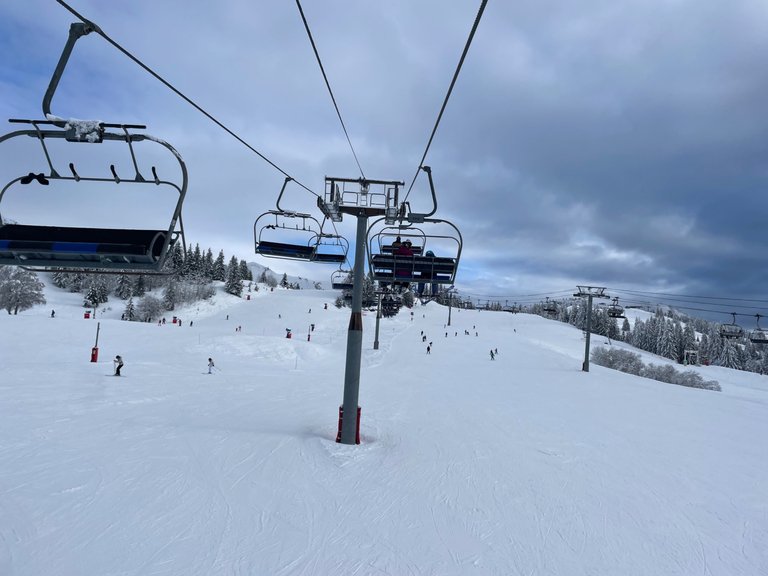
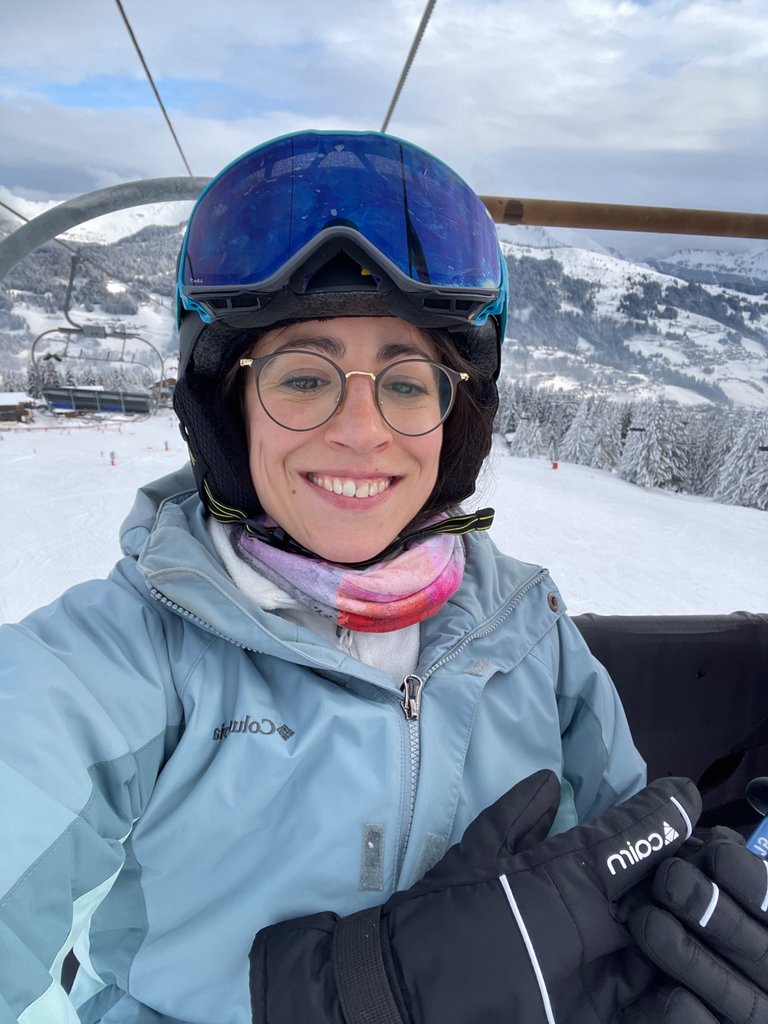
Costo del esquí
Esquiar es una actividad bastante costosa, ya que implica tener el dinero para comprarse el esquí o tabla de snowboard, casco, guantes, antiparras bastones y botas de esquí (esto también se puede alquilar por día/s, por semana o por temporada). Sumado a eso debes conseguir el pase para las telecabinas. Estos pases igualmente se alquilan por determinados días, semanas o temporada y cada uno tiene un área de influencia.
Nosotros trabajando aquí somos conseiderados temporeros, y en el caso de los temporeros las compañías ofrecen el alquiler de ski para toda la temporada junto con el pase. De esa manera es que he accedido a las telecabinas para encontrar los senderos para caminantes en alta montaña.
El costo de un pase en telecabina en el área de Les Gets que alcanza Súper Morzine, por 6 días tiene un valor de algo más de €252 para adultos, así que se imaginarán que estamos hablando de precios realmente altos. En esta tabla de la página oficial de Les Gets, pueden ver más precios.
La lección de esquí tiene un valor de €100 las 2 horas, nosotros conseguimos que nos la dejaron en €40, pero tuvimos que optar sí o sí por dos lecciones, por lo que pagamos €80. Aunque esos fueron los valores que nos pasaron a nosotros, aquí les dejo otra tabla de precios de la escuela de Ski ESF, que es a la que me mandaron a mi.
Cost of skiing
Skiing is quite an expensive activity, as it involves having the money to buy a ski or snowboard, helmet, gloves, goggles, poles and ski boots (these can also be rented by the day/s, by the week or by the season). In addition to this you must get a gondola lift pass. These passes are also rented on a daily, weekly or seasonal basis and each one has a catchment area.
We working here are considered seasonal, and in the case of seasonal the companies offer the ski rental for the whole season together with the pass. That's how I've accessed the gondola lifts to find the hiking trails in the high mountains.
The cost of a gondola pass in the Les Gets area reaching Super Morzine, for 6 days is just over €252 for adults, so you can imagine we are talking about really high prices. In this table from the official Les Gets website, you can see more prices.
The ski lesson is €100 for 2 hours, we managed to get it for €40, but we had to opt for two lessons, so we paid €80. Although those were the prices they gave us, here is another ESF Ski School price table, which is the one they sent me to.
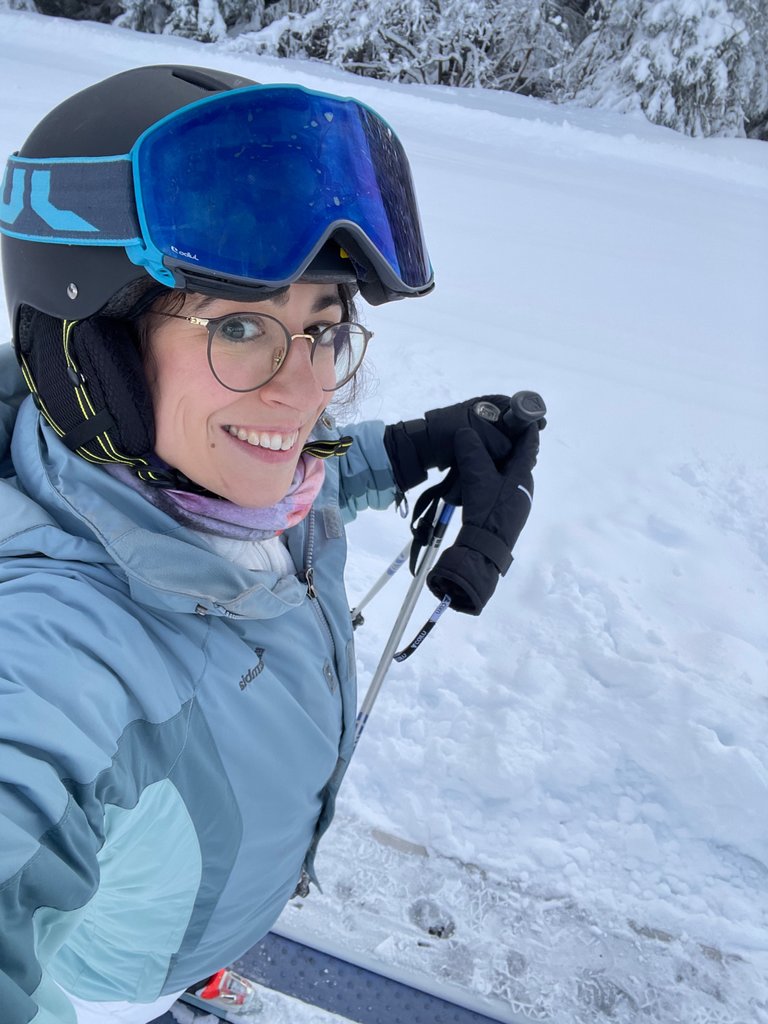
Técnicas de esquí
Claro que en esas dos horas no aprendí mucho, pero si hay algo que me quedó, es que uno va haciendo curvas en la montaña, como en forma de S. Al menos al empezar. Esto ayuda a que la velocidad no se multiplique constantemente al descender.
Al hacer las curvas, hay que elevar un costado del cuerpo para permitir que la misma gravedad te aleje o te acerque al suelo, y así aumente o disminuya la velocidad.
Los pies siempre tienen que estar paralelos, si se chocan los esquíes por delante, hay mucho riesgo de caerse porque se pierde el control de los esquíes.
Para frenar, sí que hay que activar bien las piernas, en especial aductores, y buscar llevar los esquñies juntos por delante, siempre impidiendo que choquen.
Los bastones ayudan a mantener el control en especial en las subidas o en el desplazamiento en horizontal, en llano, pero no se usan demasiado al descender.
Al agacharse, uno gana velocidad, por lo que elevar el cuerpo y extender los brazos hacia el cielo en forma de V, es una buena opción para empezar a frenar y para aprender a regular la propia velocidad. Esto es algo que se hace en velocidades leves, no cuando se va extremadamente rápido.
Skiing techniques
Of course I didn't learn much in those two hours, but if there's one thing that stuck with me, it's that you make turns on the mountain, like in an S-shape, at least at the beginning. This helps to ensure that the speed doesn't multiply constantly when descending.
When making the curves, you have to raise one side of your body to allow gravity itself to bring you closer or further away from the ground, and thus increase or decrease your speed.
Your feet must always be parallel, because if your skis collide in front of you, there is a high risk of falling because you lose control of your skis.
When braking, you must activate your legs, especially the adductors, and try to keep the skis together in front of you, always preventing them from colliding.
The poles help to maintain control, especially on ascents or when moving horizontally on the flat, but they are not used too much when descending.
When crouching down, one gains speed, so raising the body and extending the arms towards the sky in a V-shape is a good way to start braking and to learn to regulate one's own speed. This is something to do at light speeds, not when going extremely fast.
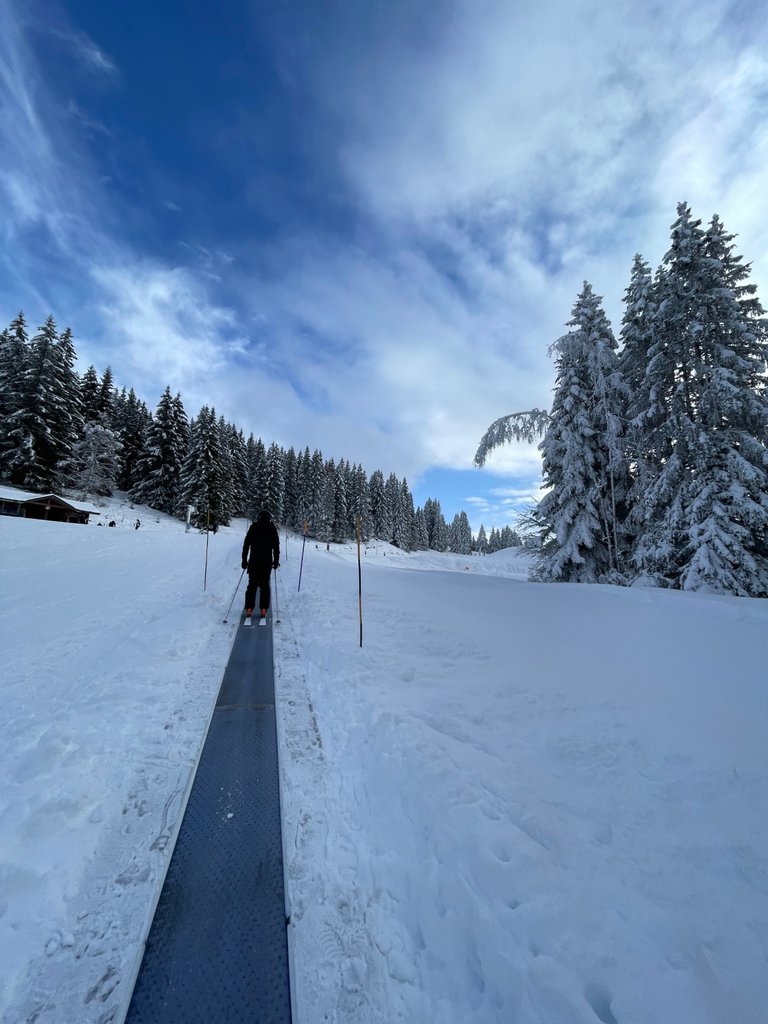
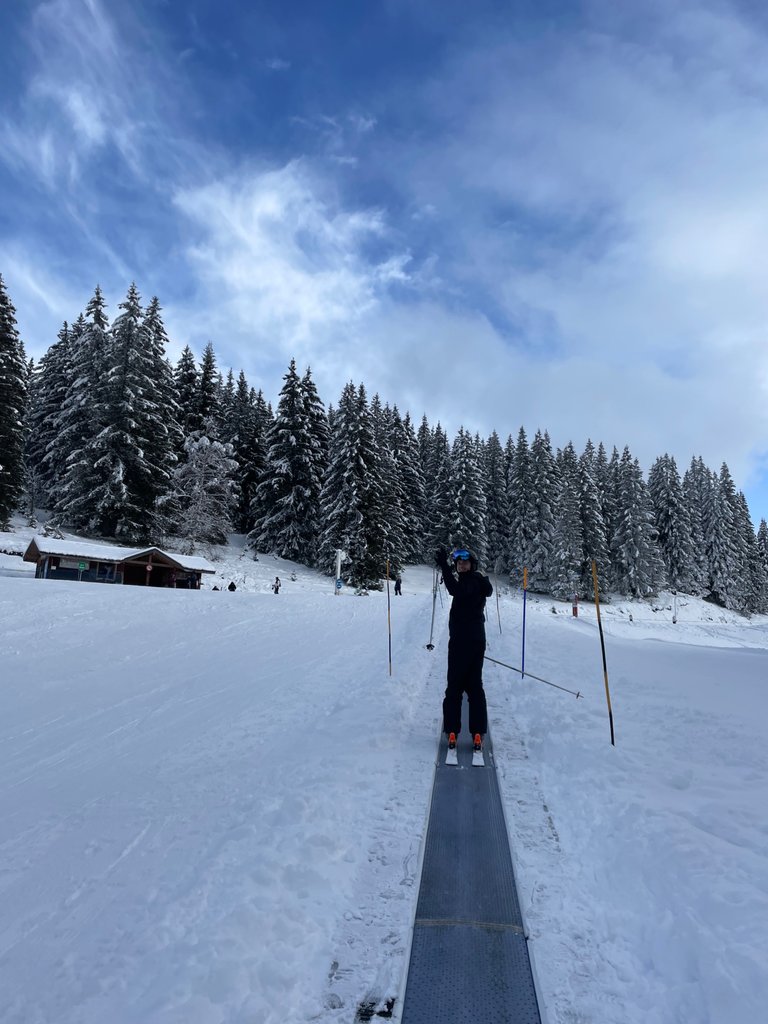

Categorizacón de las pistas de esquí
- Verde: principiantes
- Azul: fácil
- Rojo: intermedio
- Negro: experto
Nos comentaron esta información desde la compañía, pero la he corroborado en la página de interesport.
Categorisation of ski slopes
- Green: beginners
- Blue: easy
- Red: intermediate
- Black: expert
We were told this information from the company, but I have corroborated it on the interesport website.
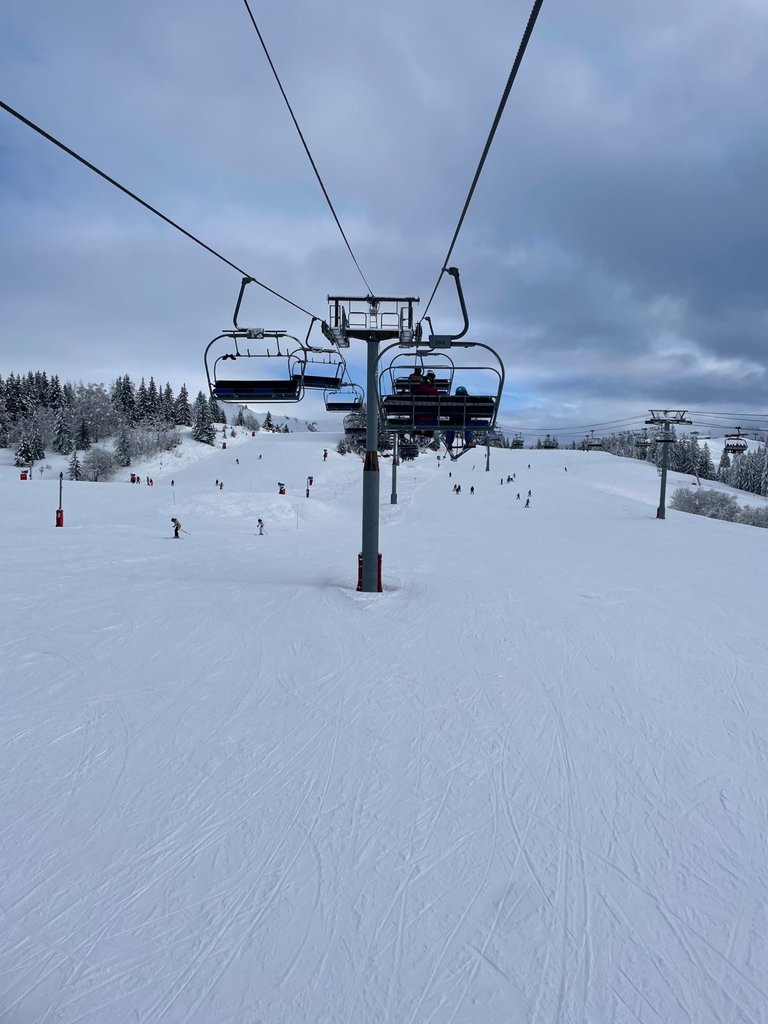
Pinmapple code: [//]:# (!pinmapple 46.14929 lat 6.68590 long Una nueva experiencia para Full Deportes; Tomé lecciones de ski por primera vez d3scr)
Music by 37085326 from Pixabay
Datos de edición
Dispositivo: iPhone 12 Pro
Banner: Canva
Aplicación de edición: CapCut Pro
Traducción: DeepL
Subtítulos: CapCut (automáticos en español y en inglés - Versión PRO)
Música (Pixabay): Sports and Adventure - 37085326
Link
Edition data
Device: iPhone 12 Pro
Banner: Canva
App for video edition: CapCut Pro
Translation: DeepL
Subtitles: CapCut (automatic in Spanish and English - PRO Version)
Música (Pixabay): Sports and Adventure - 37085326
Link


▶️ 3Speak
